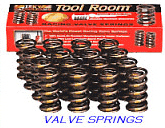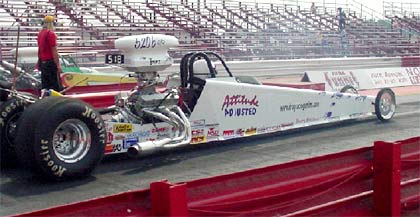|
|
|||||||||||||||||||||||||||||||||||||||||||||||||||||||||||||||||||||||||||||||||||||||||||||||||||
 |
|
||||||||||||||||||||||||||||||||||||||||||||||||||||||||||||||||||||||||||||||||||||||||||||||||||
The Real Truth about Contingency Money
If you are a racer or hang around with racers you have no doubt heard about all the money you can win if "you run the right decals" at a Divisional or national event. IHRA, NHRA, NMCA, NASCAR, etc., all sanctioning bodies brag about "all the money" you can win because of the contingency money posted by the sponsors. Well guess what.... the whole contingency system has some major flaws in it. I want to use this "Dead-On" column not to just slam the whole program but also look for ways to improve it. I'm really just another frustrated racer who is STILL waiting for contingency checks six months after winning the IHRA HCS in Cedar Falls and still hasn't collected all of the contingency that I was owed from an NHRA event ten years ago. I thought maybe I was alone but after you read this you will see I'm not. First, let's look at how the Contingency Program is supposed to work. In simple terms it is really a two-step program. You buy a product from a company that posts contingency dollars and require that you stick two of their decals on your car. Companies that post contingency money are listed in the IHRA and NHRA newspapers. A lot of racers buy and use products from those companies and that is exactly why the companies post contingency money: to sell more parts. The problem is there are some companies that simply do all they can to NOT PAY THE RACER. On the other hand, some companies pay immediately when they receive the documentation from the sanctioning body. These companies are to be commended for their support. Some companies like Zerex, Valvoline, Pyroil and Jegs pay the racers at the track on the return road at the top end! The problem area for racers and manufacturers is VERIFICATION of product use and decals. IHRA and NHRA cover their bases by telling racers it is their responsibility to get the right decals on their car and sign any releases a contingency sponsor may require. The problem is that in "real life" it is difficult to have the correct decals. Most decals are available when racers register at a National or Divisional event. If the decals are not available and you don't have them on the car count on getting no money if you win or runner-up. Now if I were a sponsor and I really did not want to pay the racers I would simply make sure I did NOT send enough decals to IHRA and NHRA. The company would still be listed as a Contingency Sponsor and get people to buy products BUT if those racers can't get decals the company will not be sending them money. Before you think this is just my opinion and that I'm on a mission to discredit contingency programs I can tell you that's not true. I'm a trusting person who believes there's good in everyone. The problem is that when it comes to a few companies I'm finding out I'm wrong. I talked to several racers about their dealings with the contingency programs before writing this column and I think their comments will prove to everyone that there is a problem. I thought the best way to start to explain the problem would be to tell you my personal experiences with collecting contingency money. I was the runner-up in Stock Eliminator at the 1991 NHRA North Star Nationals, winner at two NHRA Division 5 events in 1992 and recently won with my dragster (Project four-link) at the IHRA HCS Division in June 2001. I've spent six months so far trying to collect from the IHRA National event and it has taken from May until January to get what I was owed from the NHRA points races. I thought I was really prepared for the race this summer. I had the decals and had sent in the registration cards when they were required. Here is a description of what happened when it came time to get checked out by the IHRA official after I had won the race. They give you a list of companies and products posted for the event. You mark down the products you have and then they come back and verify the decals. I made the mistake of not checking what he was doing closely enough. He did not mark down I had decals for some of the products I claimed. I didn't notice this and I'm to blame for that. When some companies refused to pay because of lack of decals I sent photos of the car in the winner's circle that proved I had the decals on the car. I also sent in copies of invoices to prove I had bought the products. It has been six months and I am still waiting for $400. Now for the nitty-gritty, who paid and who didn't. Best paying companies: The "slow pokes." Now for really slow ones that I had to write letters to and call,
send winner circle photos and emailing them asking to be paid: Now, the companies that have NOT PAID: I am not sure why they won't pay and I sure wish they would at least respond to my letters. I sent them photos of the car, part numbers of the parts I use and copies of receipts when available. I'm not sure what else I'm supposed to do. So far this has been just my sad story. Here is what some other racers had to say that I contacted for this story. I hoped to see some racers at the PRI Show in Indy whom I knew would have first hand knowledge of how the contingency programs work and where they fail. I talked to Edmond Richardson, past NHRA World Champion and winner of dozens of races he earned contingency payments at. I also set up a call with Luke Bogacki whose past couple seasons have him as a threat to win an IHRA National Championship and about any race he enters. The third racer I got in touch with was one of NHRA's Top 50 racers of all time, Scotty Richardson. He earns contingency awards as often as anyone and his comments are very innovative. I asked these guys some common questions and all of them had similar answers. I also asked them what companies paid the best and which ones paid the worst. I also told these three world-class racers I would not quote them on who they said was the WORST PAYING COMPANIES. (They make their living doing this and I don't want to make it more difficult. I think they were pretty brave to even let me use their names.) It was actually kind of funny when we started writing the company names down, the same names came up each time. Here is the list of companies that those racers told me are the slowest paying and in some cases still haven't paid what they owe for events these racers won early in the 2001 season. In no particular order they are: Powermaster, Manley, JW Transmission , Holley performance, CSI and some others. I don't understand why these companies spend so much money advertising in racer magazines then are so slow in paying their contingency award obligations. The general consensus of my "blue ribbon panel" was that the contingency programs in general need a major reconstruction. Here are their ideas and some comments: 1. All racers should still be responsible for obtaining and installing the proper decals for ONLY the products they use on that racecar. A false claim or decal should result in a "cash fine" equal to one contingency payment. 2. They all thought a system should be in place where racers can "pre- register" with sponsors to get proper decals and products verified before the season starts. With this also comes a commitment from the racers to run the products he has signed up for. 3. It was unanimous that racers should receive their contingency money immediately after the event. At the very least all products that can be visually verified should be paid for immediately. It is ridiculous that it takes up to 6 months for some companies to pay. 4. The products that can't be visually verified (connecting rods, valve springs, motor oil, converters, etc) could be done at this time if the racer had "pre- registered" with the sponsor or brings the proper receipts to the race with him (or her). 5. Any company that does NOT pay within 60 days should be "fined" the amount they posted and that "fine" should be paid by the sanctioning body to the racer along with the amount they should have been paid in the first place. Right now there just isn't much support from NHRA and IHRA for the racer who has earned their contingency awards but can't seem to collect it. My interviews did conclude that Karen Raffa, of the IHRA, worked the hardest to get the racer in touch with the "right person" at the company who was not paying. I know a lot of you think this article is the "whining" of a few racers who already win a lot of money. Well, you are wrong. This is an obligation that most companies take seriously and the other companies should be made to take seriously or get off the list of contingency sponsors. Until you have won an event that pays contingency it is difficult to understand the frustration. I felt I prepared as good as I could, luck fell my way when I needed it and I purchased the products that promised to pay contingency dollars. That IS ALL I SHOULD HAVE TO DO. The rest should be up to the IHRA and NHRA to make sure their sponsors pay in a timely fashion. Race on my friends, and make sure you have the right decals on when you get that first BIG WIN! Got some comments or experiences with this subject? email me for a
possible follow up story: jok@racingnetsource.com
|
|||||||||||||||||||||||||||||||||||||||||||||||||||||||||||||||||||||||||||||||||||||||||||||||||||















